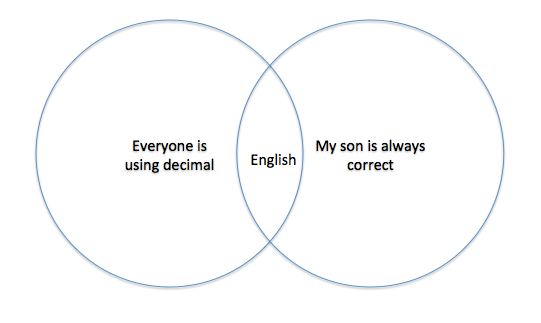2 + 2 can be 22
I recently found this well-made short film, Alternative Math, https://www.youtube.com/watch?v=Zh3Yz3PiXZw. It became again after the University of Carlifornia decided to stop using ACT/SAT.
I am a father of two young children, and I think everyone, including the teacher in the film, can do better.
The film and 2 + 2 = 22
The film talks about a little kid who thinks 2 + 2 = 22, the teacher says it’s wrong, and it should be 4. The parents and the public criticize the teacher of Nazism, that only her answers were acceptable and others were wrong. At the end of the film, the teacher is fired from the school, and is given two paychecks $2,000 each. The principal says $2,000 + $2,000 = $4,000. The teacher says, “Wrong! It should be $22,000.”
2 + 2 can be 22
Symbols like “1”, “2”, and “apple”, are only meaningful because we assign them meanings. “2” can be a symbol in an unary number system, in which case 2 + 2 = 22, is correct. In this case, 22, however it’s being pronounced, means two. “Apple” can be used to describe the item in the picture below.

“Apple” only means apple because we all agree on this definition.
2 + 2 only equals 4 under certain conditions, and 2 + 2 equaling to 22 is not wrong in all possible conditions. This reminds me of Newton’s laws of motion, because these equations are accurate in many cases but not in all. Try imagining a teacher telling young Einstein that one can just keep pushing a box, and eventually it can be faster than the speed of light. Instead of just telling the child, 2 + 2 = 22 is wrong, it would be the perfect opportunity to teach the kid about the number system.
At the end of the film, the teacher says $2,000 + $2,000 is $22,000, which is different from the child saying 2 + 2 = 22 because “2 + 2” is an abstract expression, but $2,000 is not. The number on the bill is a decimal, which everyone has to agree on in order for money to work. You can choose to believe the number “100” on an $100 bill is actually binary and it’s actually an $8 dollar bill, but it’s only useful if everyone agrees on it.
Communication
The very foundation of communication is that multiple parties agreeing on something to begin with, e.g. “apple” means apple. And usually the goal of communication is that we expand consensus. At the very beginning, who decide apples are called “apples”? Someone must name it first and others went along. That’s why when we communicate, we make a lot of assumptions, e.g. “apples” means apples, everyone is using decimals, etc. These assumptions are usually fine and it makes communication much more efficient. But when we run into conflicts, we should re-think our assumptions.

If I were the teacher, I should think about did I miss anything from the parents? Can 2 + 2 = 22 in some cases (the answer is yes). Am I making assumptions but not being explicit about them? And the same thing applies to the parents and others in the film.
When there’s a disagreement, it’s tempting to make people on the other side look stupid and attract attention. It’s hard to communicate and understand the differences we have and the assumptions we are making. The former keeps dividing the country and the people. The latter unites the people and communities.